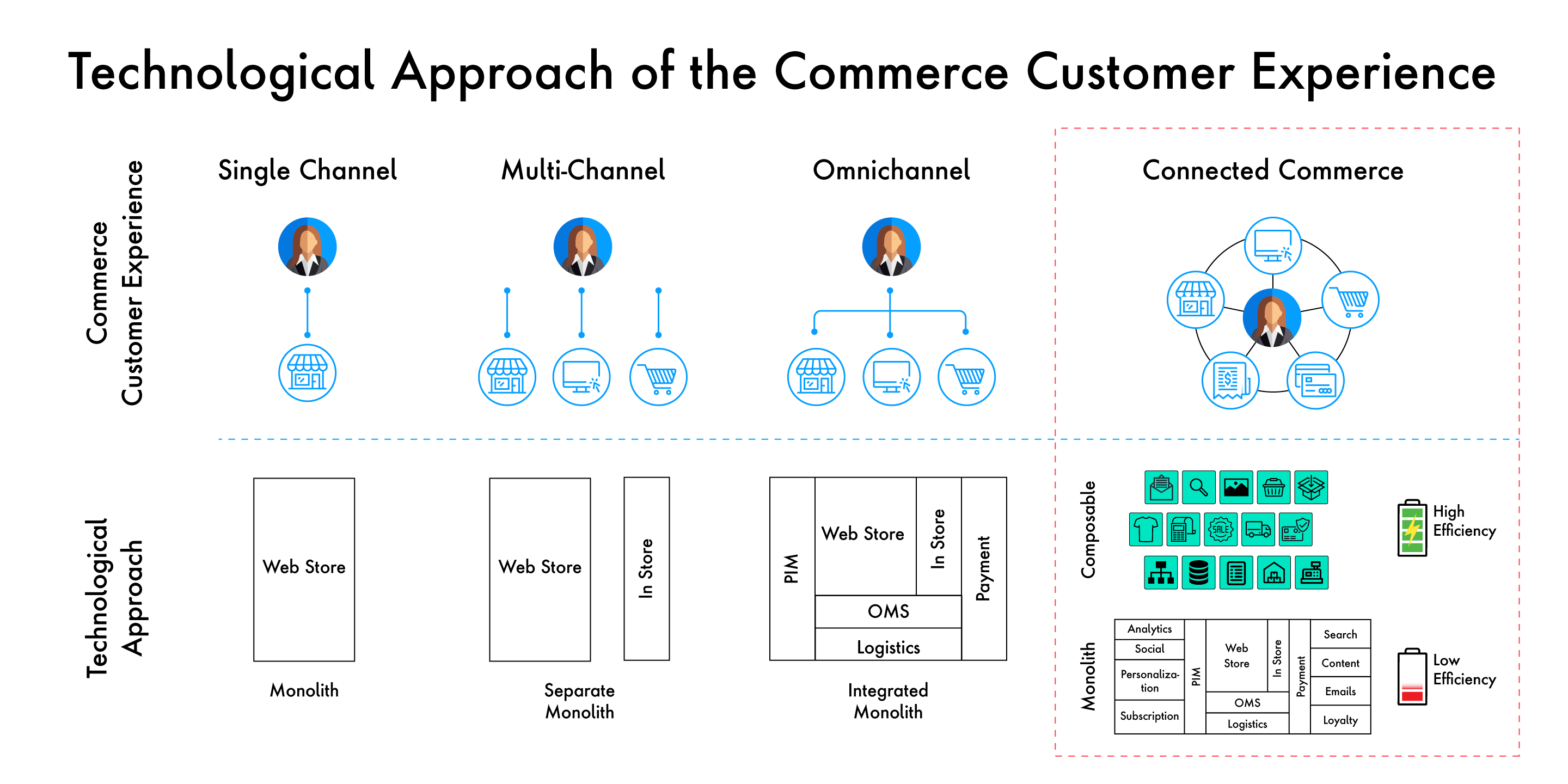What issue can we solve for you?
Type in your prompt above or try one of these suggestions
Suggested Prompt



Insight
Composable Commerce Is the Future and the Future Is Now
Composable Commerce Is the Future and the Future Is Now
Composable Commerce's innovative architectural approach enables businesses to choose best-in-class, independent components that meet business capabilities and needs.
What Is Composable Commerce?
In recent years we’ve seen a huge increase in the number of businesses adopting omnichannel strategies designed to penetrate the transactional journeys. Yet innovative organizations are pushing forward, looking for the next wave in commerce experience to differentiate their brands and capture a higher level of economic value in the experience economy that we live in. That next wave has arrived, and it is the Connected experience offering a more personalized and consistent brand experience across all touchpoints. And it is easily achievable through Composable Commerce.
Organizations have high hopes for Composable Commerce, expecting it to be more connected and agile to create superior customer experiences. Arguably the future of e-commerce, composable architecture empowers brands and retailers to meet customers’ ever-shifting demands by combining customization and individualization.

A composable architecture empowers Connected Commerce, creating superior customer experiences.
Composable Commerce's innovative architectural approach enables businesses to choose best-in-class, independent components that meet business capabilities and needs. It is a future-proof strategy and supports multiple business models, brands, regions and customer types. Modularity is key to simplifying the system, making it efficient and flexible for companies while delivering a seamless connected experience to customers.
To achieve the promise of Composable Commerce, an organization should begin by adopting a customer-first perspective and then work backward to identify and build a packaged business capability using modern composable technologies.
Why Adopt Composable Commerce?
The benefits of Composable Commerce are many and varied. Beyond enabling scalability, Composable Commerce can be leveraged externally to deliver better customer experiences and internally to future-proof operations.
1. Meet Customer Expectations
Composable Commerce’s modularity lets teams add and remove applications seamlessly rather than working on an entire system. This flexibility allows brands to design superior personalized customer journeys that go beyond omnichannel to reach offline and digital touchpoints. The result is agile organizations and delighted customers.
2. Tailored Tech Stacks
Composable Commerce enables organizations to adopt and facilitate a customer-centric approach to e-commerce. With Composable Commerce’s pre-packaged integrations, teams can often accelerate to make essential application changes and rapidly meet shifting market demands. This level of flexibility also delivers unprecedented scalability so brands can ramp up or down based on market conditions. Tech stacks can be ultra-tailored as composable commerce provides the ability to pick and choose the technology required for optimum performance.
3. Efficiency in Fully Connected Systems
Unlike monolithic systems, composable architecture is modular, meaning components can be swapped in or out at any time. This plug-and-play functionality ramps up efficiencies across the board, including lower total cost of ownership, faster time to market, and innovation at scale.
These are just three benefits of composable out of the many that help brands provide exceptional experiences.

Unlock Your Potential with Composable Commerce and Salesforce
So, what exactly does a business need to take the next step? In addition to a digital transformation mindset, you’ll also need a flexible and efficient infrastructure, modern technologies, and high-performing teams. The best way to adopt a composable approach is gradually with deployments of capabilities and have a hybrid platform for a period of time. Capture value incrementally and move from the culture of re-platforming projects every few years to a culture of constant product evolution.
The software vendors in the commerce industry have created an ecosystem of headless and composable offerings in recent years. Salesforce is leading this space with its robust Core Commerce offering, Composable Storefront, and headless capabilities. The deployment of Salesforce Commerce Cloud composable infrastructure accelerates the adoption of modern technologies and enables the transition toward a composable approach. Their pre-packaged solutions enable increased speed time and reduce total cost of ownership. Salesforce’s composable solution puts the customer first with its progressive web app technology, providing consumers a seamless online shopping experience with minimized load time and decreased disruption.
We have already proven the SFCC extensible methodology through our RACE (Rapid Accelerator for Commerce Engineering) solution, which provides many integrations to the traditional SFCC using industry best practices based on our wide array of clients in the space. We have enhanced the solution to accommodate a composable approach. By applying our Composable RACE solution with pre-build capabilities integrations, the transition to composable is accelerated further.
Our experience extends decades, making us a trusted Salesforce partner with a proven track record through our RACE (Rapid Accelerator for Commerce Engineering) solutions. With Salesforce’s robust and dependable Composable Commerce solution and our guidance, organizations can unlock the agility and flexibility they need to outdistance the competition.
Related Reading
-
![]()
Future of Composable Commerce with Salesforce
Retailers need to have the agility to leverage composability and a modern architecture while requiring the robust capabilities and dependability of a platform like Salesforce in today’s competitive environment.
-
![]()
Composable Commerce Accelerator
Get composable commerce up and running in as little as 6 weeks, so you can build and flex with your exact specifications to meet shopper needs.
-
![]()
Gaming Retailer Levels Up Its Omnichannel Ecosystem
A scalable digital strategy and experience meets the needs of the next generation and yields major revenue gains.







